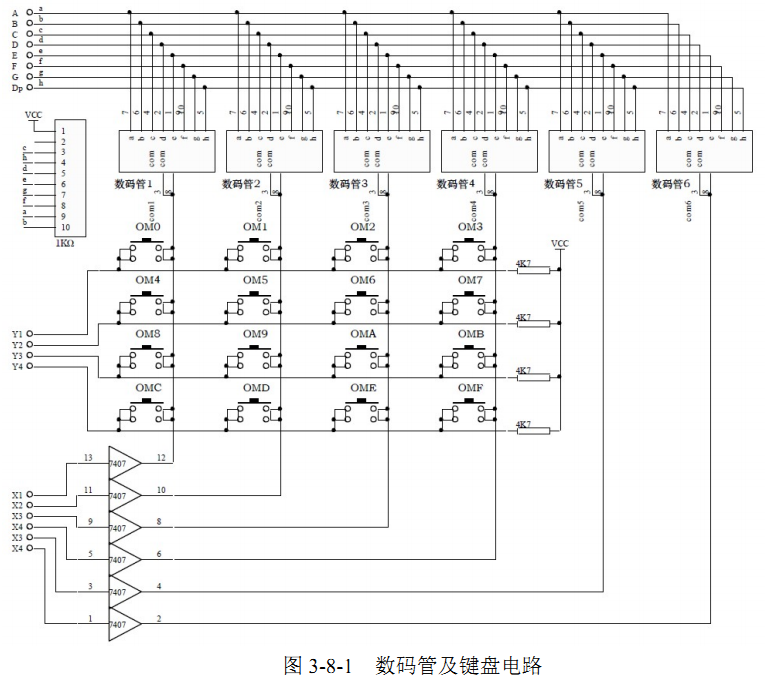Experiment 8: nixie tube display experiment
1. Experimental purpose
- Learn the basic principle of "seven section common cathode nixie tube" display;
- Master the method of controlling multiple nixie tube displays through parallel interface chip.
2. Experimental content
Use port A and port B of an 8255 interface chip to connect the digital tube segment code interface (ABCDEFG Dp) and bit code interface (X1~X6) respectively. Write A program to realize the following two display modes:
- Make the six digit nixie tube display the moving numbers 0 to 9 bit by bit from right to left, that is, the number 0 moves from the rightmost end to the leftmost end, the number 1 moves from the rightmost end to the leftmost end,..., and the number 9 moves from the rightmost end to the leftmost end, and cycle the above process;
- Make the six digit nixie tube display the stable number "123456" from left to right.
3. Experimental principle
The schematic diagram and display effect of 7-segment common cathode nixie tube are shown in figure 3-8-1, including 7 strokes A ~ G and a decimal point Dp. The 7-segment common cathode nixie tube displays 0 ~ 9, A ~ F, and its codes are 3FH, 06H, 5BH, 4FH, 66H, 6DH, 7DH, 07H, 7FH, 6FH, 77H, 7CH, 39H, 5EH, 79H and 71H. When the decimal point "." is displayed, the highest bit on the current code is set to 1 (80H). The available code 00H is off, or the set selection signal is invalid.

The circuit and external interface of six digit nixie tube are shown in figure 3-9-1. The specific nixie tube can be selected and lit through the bit selection signal (X1~X6), and the specific number can be displayed through the input segment code (ABCDEFG Dp). When multiple digits are displayed at the same time, the bit code can be scanned.

4. Experimental records
-
Bit selection signal: there are 6 nixie tubes on the machine. You can select which nixie tubes the segment selection signal is output to through ports X1 ~ X6. It can be seen from the circuit diagram that when X1 ~ X6 ports output 1, it is not selected, and when 0 is output, it is selected.
-
Segment selection signal: there are 8 segments of LED lights in the nixie tube. The corresponding LED lights are on and off by inputting 8-bit binary digital selection control. Input 1 to control on, and input 0 to control off.
-
Display problem: each time another nixie tube is selected, the original lit nixie tube will be extinguished because its bit selection signal is set to 0 and the bit selection signal of the other nixie tube is set to high. So we should write six nixie tubes in a six cycle, and an external dead cycle to make the six nixie tubes always on.
-
Experiment 1: cyclic shift display 0 to 9
A8255 EQU 0640H ;8255 Port A Address of B8255 EQU 0642H ;8255 Port B Address of C8255 EQU 0644H ;8255 Port C Address of M8255 EQU 0646H ;8255 Control address of DATA SEGMENT TAB: DB 3FH,06H,5BH,4FH,66H,6DH,7DH,07H,7FH,6FH DATA ENDS CODE SEGMENT ASSUME CS:CODE,DS:DATA START: MOV AX,DATA MOV DS,AX ;These two lines can DATA Data import using MOV DX,M8255 MOV AL,80H OUT DX,AL ;Set the control mode of 8255 as ABC All ports output LEA BX,TAB ;deposit TAB First address of MOV SI,00H ;Address offset MAIN: MOV AL,11011111B ;Initial setting of bit code selection, select the nixie tube at the rightmost end MOV CX,06H ;set up LOOP The number of cycles is 6 M1: MOV DX,A8255 OUT DX,AL ;First output bit selection through 8255 SHR AL,1 ;Shift the bit selection one bit to the right OR AL,11000000B ;Due to the right shift and zero filling, you need to manually change 0 to 1 PUSH AX ;preservation AX Value of MOV DX,B8255 MOV AL,[BX+SI] ;TAB First address+Address offset OUT DX,AL ;Output segment code selection through 8255 POP AX ;Take out the saved AX Value of CALL DELAY ;A delay is required LOOP M1 ;LOOP Loop, return M1 Tag bit INC SI ;If the address offset increases, the segment selection code of the next number will be selected CMP SI,0AH ;Detect whether the offset is out of range JNE M1F ;Jump without crossing the boundary MOV SI,00H ;Set zero when crossing the boundary M1F: JMP MAIN DELAY: ;A visible delay, about 3/10 Seconds or so PUSH BX PUSH CX MOV BX, 0003H DEL2: MOV CX, 0FFFFH DEL3: LOOP DEL3 DEC BX JNZ DEL2 POP CX POP BX RET CODE ENDS END START
- Experiment 2: stably display numbers 1 ~ 6 (only important codes are recorded here because some codes are repeated)
LEA BX,TAB ;deposit TAB First address of MAIN2: MOV AL,11011111B ;Bit code selection initial setting MOV SI,00H ;Address offset MOV CX,06H ;set up LOOP Number of cycles M2: MOV DX,A8255 OUT DX,AL ;First input the bit selection code SHR AL,1 ;Bit selection right shift OR AL,11000000B PUSH AX MOV DX,B8255 MOV AL,[BX+SI] ;Re output segment code selection OUT DX,AL POP AX INC SI ;Auto increment offset, select the next number CALL DELAY ;A short delay is required LOOP M2 ;LOOP loop JMP MAIN2 DELAY: ;A short delay PUSH BX MOV BX, 01FFH DEL: DEC BX JNZ DEL POP BX RET
5. Extended experiment
No, no code.